display FIAT DUCATO BASE CAMPER 2015 Owner handbook (in English)
[x] Cancel search | Manufacturer: FIAT, Model Year: 2015, Model line: DUCATO BASE CAMPER, Model: FIAT DUCATO BASE CAMPER 2015Pages: 367, PDF Size: 19.73 MB
Page 90 of 367
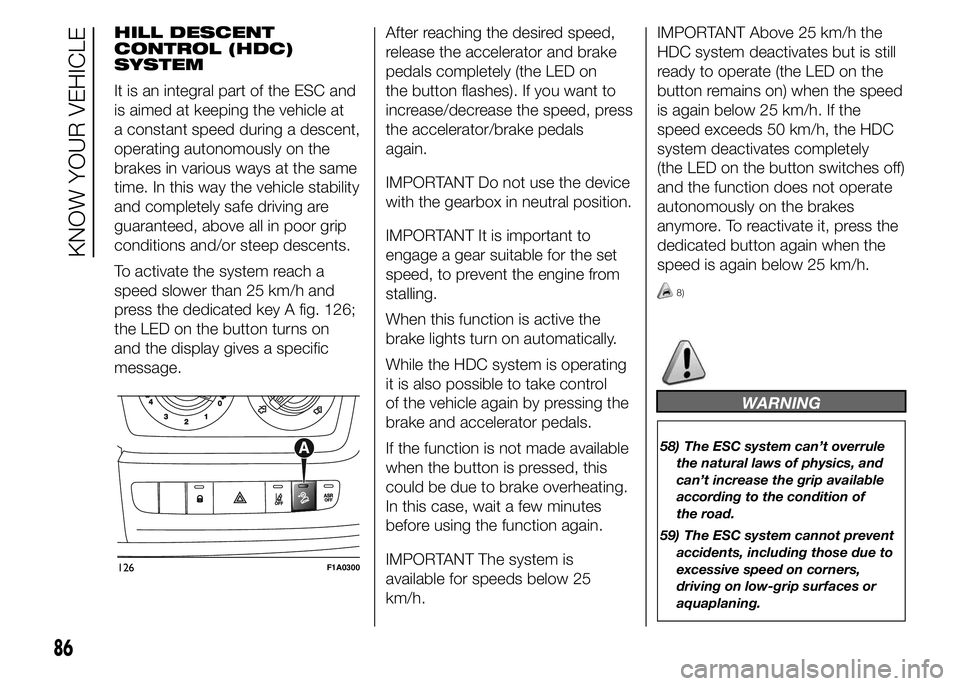
HILL DESCENT
CONTROL (HDC)
SYSTEM
It is an integral part of the ESC and
is aimed at keeping the vehicle at
a constant speed during a descent,
operating autonomously on the
brakes in various ways at the same
time. In this way the vehicle stability
and completely safe driving are
guaranteed, above all in poor grip
conditions and/or steep descents.
To activate the system reach a
speed slower than 25 km/h and
press the dedicated key A fig. 126;
the LED on the button turns on
and the display gives a specific
message.After reaching the desired speed,
release the accelerator and brake
pedals completely (the LED on
the button flashes). If you want to
increase/decrease the speed, press
the accelerator/brake pedals
again.
IMPORTANT Do not use the device
with the gearbox in neutral position.
IMPORTANT It is important to
engage a gear suitable for the set
speed, to prevent the engine from
stalling.
When this function is active the
brake lights turn on automatically.
While the HDC system is operating
it is also possible to take control
of the vehicle again by pressing the
brake and accelerator pedals.
If the function is not made available
when the button is pressed, this
could be due to brake overheating.
In this case, wait a few minutes
before using the function again.
IMPORTANT The system is
available for speeds below 25
km/h.IMPORTANT Above 25 km/h the
HDC system deactivates but is still
ready to operate (the LED on the
button remains on) when the speed
is again below 25 km/h. If the
speed exceeds 50 km/h, the HDC
system deactivates completely
(the LED on the button switches off)
and the function does not operate
autonomously on the brakes
anymore. To reactivate it, press the
dedicated button again when the
speed is again below 25 km/h.
8)
WARNING
58) The ESC system can’t overrule
the natural laws of physics, and
can’t increase the grip available
according to the condition of
the road.
59) The ESC system cannot prevent
accidents, including those due to
excessive speed on corners,
driving on low-grip surfaces or
aquaplaning.
126F1A0300
86
KNOW YOUR VEHICLE
Page 96 of 367
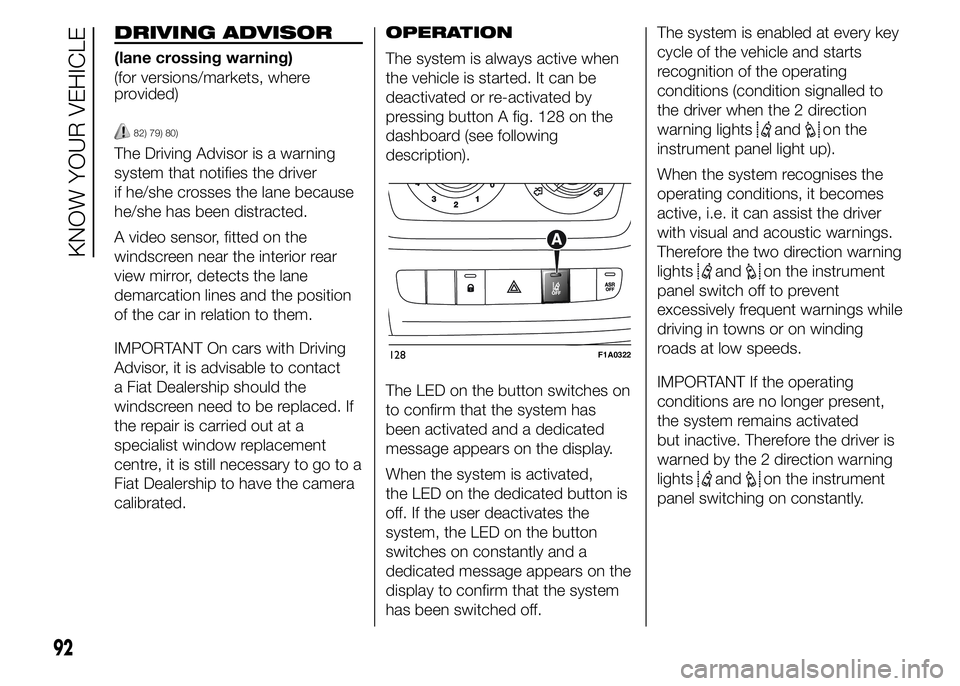
DRIVING ADVISOR
(lane crossing warning)
(for versions/markets, where
provided)
82) 79) 80)
The Driving Advisor is a warning
system that notifies the driver
if he/she crosses the lane because
he/she has been distracted.
A video sensor, fitted on the
windscreen near the interior rear
view mirror, detects the lane
demarcation lines and the position
of the car in relation to them.
IMPORTANT On cars with Driving
Advisor, it is advisable to contact
a Fiat Dealership should the
windscreen need to be replaced. If
the repair is carried out at a
specialist window replacement
centre, it is still necessary to go to a
Fiat Dealership to have the camera
calibrated.OPERATION
The system is always active when
the vehicle is started. It can be
deactivated or re-activated by
pressing button A fig. 128 on the
dashboard (see following
description).
The LED on the button switches on
to confirm that the system has
been activated and a dedicated
message appears on the display.
When the system is activated,
the LED on the dedicated button is
off. If the user deactivates the
system, the LED on the button
switches on constantly and a
dedicated message appears on the
display to confirm that the system
has been switched off.The system is enabled at every key
cycle of the vehicle and starts
recognition of the operating
conditions (condition signalled to
the driver when the 2 direction
warning lights
andon the
instrument panel light up).
When the system recognises the
operating conditions, it becomes
active, i.e. it can assist the driver
with visual and acoustic warnings.
Therefore the two direction warning
lights
andon the instrument
panel switch off to prevent
excessively frequent warnings while
driving in towns or on winding
roads at low speeds.
IMPORTANT If the operating
conditions are no longer present,
the system remains activated
but inactive. Therefore the driver is
warned by the 2 direction warning
lights
andon the instrument
panel switching on constantly.
128F1A0322
92
KNOW YOUR VEHICLE
Page 97 of 367
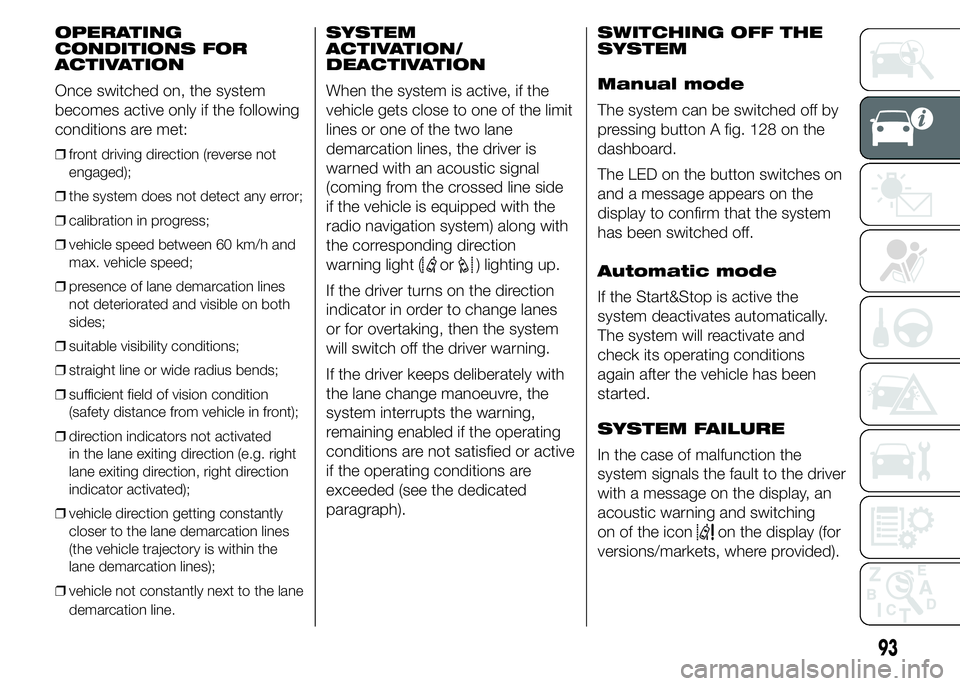
OPERATING
CONDITIONS FOR
ACTIVATION
Once switched on, the system
becomes active only if the following
conditions are met:
❒front driving direction (reverse not
engaged);
❒the system does not detect any error;
❒calibration in progress;
❒vehicle speed between 60 km/h and
max. vehicle speed;
❒presence of lane demarcation lines
not deteriorated and visible on both
sides;
❒suitable visibility conditions;
❒straight line or wide radius bends;
❒sufficient field of vision condition
(safety distance from vehicle in front);
❒direction indicators not activated
in the lane exiting direction (e.g. right
lane exiting direction, right direction
indicator activated);
❒vehicle direction getting constantly
closer to the lane demarcation lines
(the vehicle trajectory is within the
lane demarcation lines);
❒vehicle not constantly next to the lane
demarcation line.
SYSTEM
ACTIVATION/
DEACTIVATION
When the system is active, if the
vehicle gets close to one of the limit
lines or one of the two lane
demarcation lines, the driver is
warned with an acoustic signal
(coming from the crossed line side
if the vehicle is equipped with the
radio navigation system) along with
the corresponding direction
warning light (
or) lighting up.
If the driver turns on the direction
indicator in order to change lanes
or for overtaking, then the system
will switch off the driver warning.
If the driver keeps deliberately with
the lane change manoeuvre, the
system interrupts the warning,
remaining enabled if the operating
conditions are not satisfied or active
if the operating conditions are
exceeded (see the dedicated
paragraph).SWITCHING OFF THE
SYSTEM
Manual mode
The system can be switched off by
pressing button A fig. 128 on the
dashboard.
The LED on the button switches on
and a message appears on the
display to confirm that the system
has been switched off.
Automatic mode
If the Start&Stop is active the
system deactivates automatically.
The system will reactivate and
check its operating conditions
again after the vehicle has been
started.
SYSTEM FAILURE
In the case of malfunction the
system signals the fault to the driver
with a message on the display, an
acoustic warning and switching
on of the icon
on the display (for
versions/markets, where provided).
93
Page 99 of 367
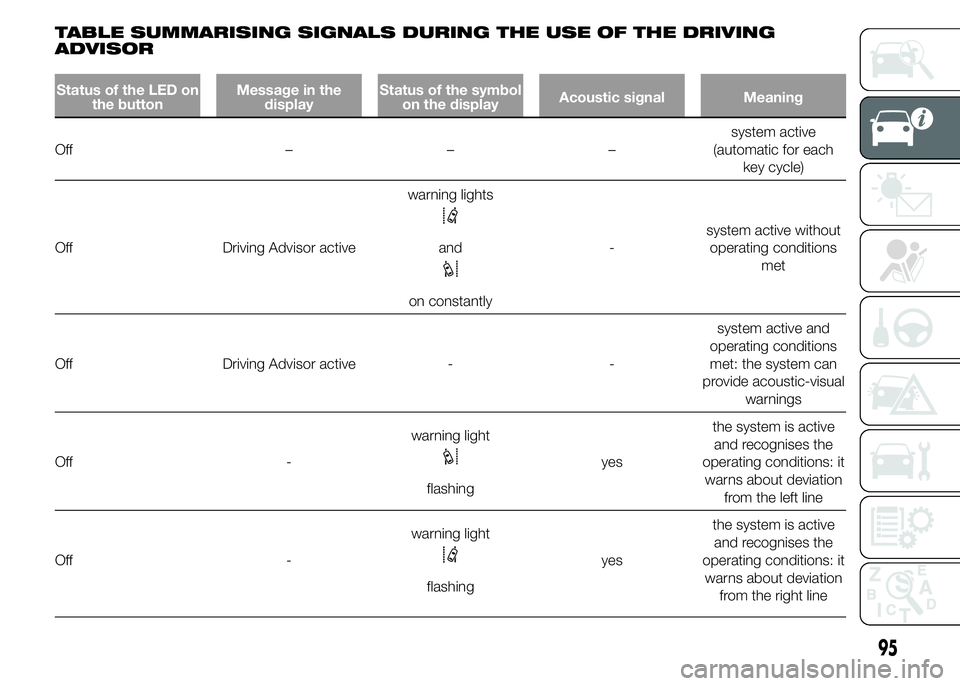
TABLE SUMMARISING SIGNALS DURING THE USE OF THE DRIVING
ADVISOR
Status of the LED on
the buttonMessage in the
displayStatus of the symbol
on the displayAcoustic signal Meaning
Off – – –system active
(automatic for each
key cycle)
Off Driving Advisor activewarning lights
and
on constantly-system active without
operating conditions
met
Off Driving Advisor active - -system active and
operating conditions
met: the system can
provide acoustic-visual
warnings
Off -warning light
flashingyesthe system is active
and recognises the
operating conditions: it
warns about deviation
from the left line
Off -warning light
flashingyesthe system is active
and recognises the
operating conditions: it
warns about deviation
from the right line
95
Page 100 of 367
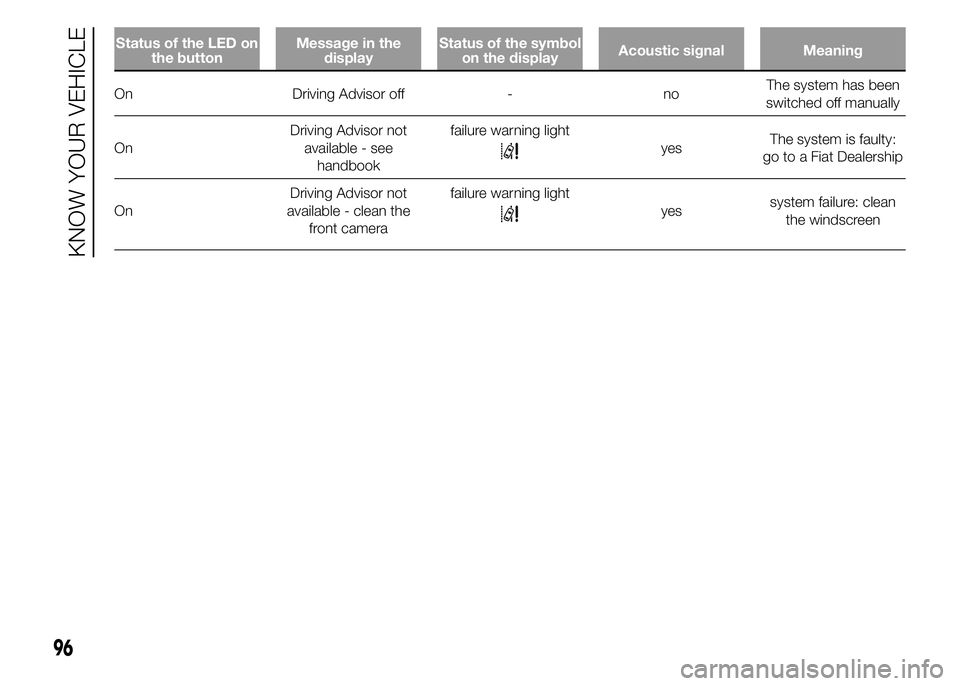
Status of the LED on
the buttonMessage in the
displayStatus of the symbol
on the displayAcoustic signal Meaning
On Driving Advisor off - noThe system has been
switched off manually
OnDriving Advisor not
available - see
handbookfailure warning light
yesThe system is faulty:
go to a Fiat Dealership
OnDriving Advisor not
available - clean the
front camerafailure warning light
yessystem failure: clean
the windscreen
96
KNOW YOUR VEHICLE
Page 101 of 367
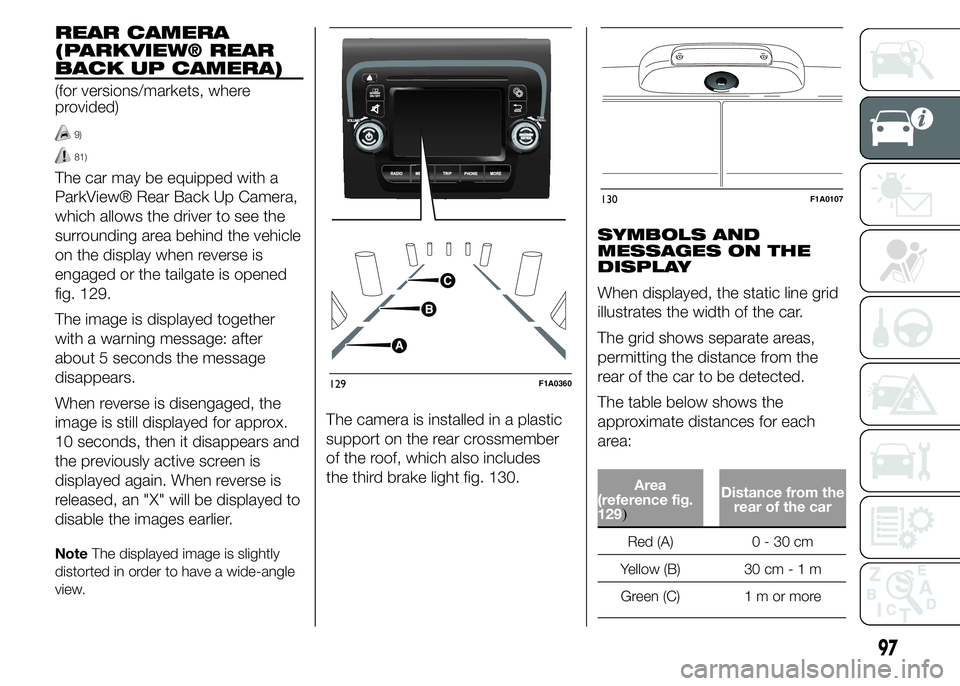
REAR CAMERA
(PARKVIEW® REAR
BACK UP CAMERA)
(for versions/markets, where
provided)
9)
81)
The car may be equipped with a
ParkView® Rear Back Up Camera,
which allows the driver to see the
surrounding area behind the vehicle
on the display when reverse is
engaged or the tailgate is opened
fig. 129.
The image is displayed together
with a warning message: after
about 5 seconds the message
disappears.
When reverse is disengaged, the
image is still displayed for approx.
10 seconds, then it disappears and
the previously active screen is
displayed again. When reverse is
released, an "X" will be displayed to
disable the images earlier.
NoteThe displayed image is slightly
distorted in order to have a wide-angle
view.
The camera is installed in a plastic
support on the rear crossmember
of the roof, which also includes
the third brake light fig. 130.SYMBOLS AND
MESSAGES ON THE
DISPLAY
When displayed, the static line grid
illustrates the width of the car.
The grid shows separate areas,
permitting the distance from the
rear of the car to be detected.
The table below shows the
approximate distances for each
area:
Area
(reference fig.
129
)
Distance from the
rear of the car
Red (A) 0 - 30 cm
Yellow (B) 30 cm-1m
Green (C) 1 m or more
129F1A0360
130F1A0107
97
Page 103 of 367
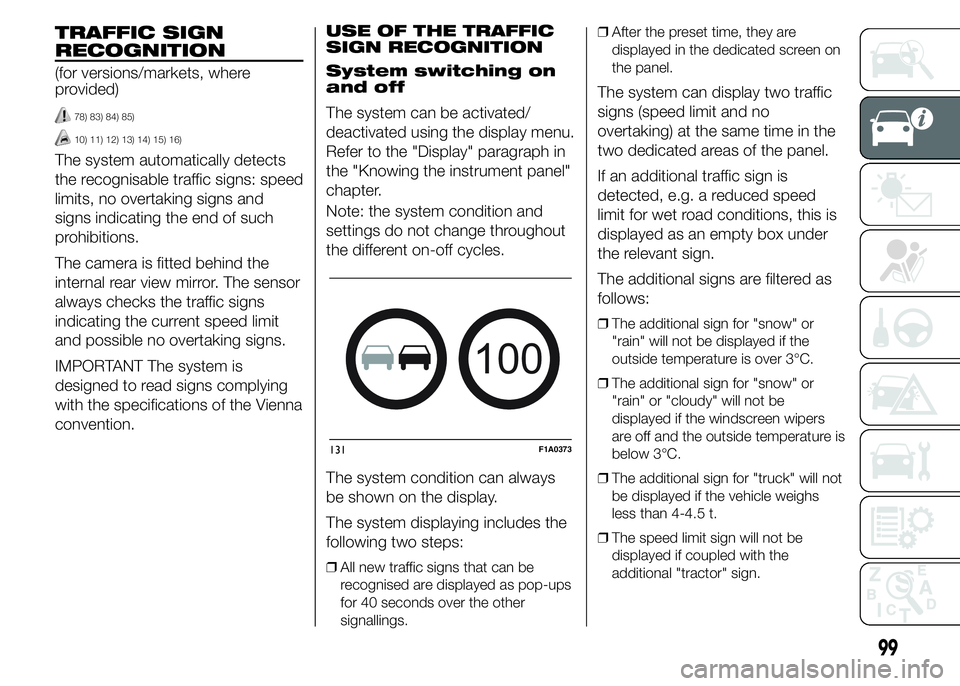
TRAFFIC SIGN
RECOGNITION
(for versions/markets, where
provided)
78) 83) 84) 85)
10) 11) 12) 13) 14) 15) 16)
The system automatically detects
the recognisable traffic signs: speed
limits, no overtaking signs and
signs indicating the end of such
prohibitions.
The camera is fitted behind the
internal rear view mirror. The sensor
always checks the traffic signs
indicating the current speed limit
and possible no overtaking signs.
IMPORTANT The system is
designed to read signs complying
with the specifications of the Vienna
convention.USE OF THE TRAFFIC
SIGN RECOGNITION
System switching on
and off
The system can be activated/
deactivated using the display menu.
Refer to the "Display" paragraph in
the "Knowing the instrument panel"
chapter.
Note: the system condition and
settings do not change throughout
the different on-off cycles.
The system condition can always
be shown on the display.
The system displaying includes the
following two steps:
❒All new traffic signs that can be
recognised are displayed as pop-ups
for 40 seconds over the other
signallings.❒After the preset time, they are
displayed in the dedicated screen on
the panel.
The system can display two traffic
signs (speed limit and no
overtaking) at the same time in the
two dedicated areas of the panel.
If an additional traffic sign is
detected, e.g. a reduced speed
limit for wet road conditions, this is
displayed as an empty box under
the relevant sign.
The additional signs are filtered as
follows:
❒The additional sign for "snow" or
"rain" will not be displayed if the
outside temperature is over 3°C.
❒The additional sign for "snow" or
"rain" or "cloudy" will not be
displayed if the windscreen wipers
are off and the outside temperature is
below 3°C.
❒The additional sign for "truck" will not
be displayed if the vehicle weighs
less than 4-4.5 t.
❒The speed limit sign will not be
displayed if coupled with the
additional "tractor" sign.
100
131F1A0373
99
Page 104 of 367
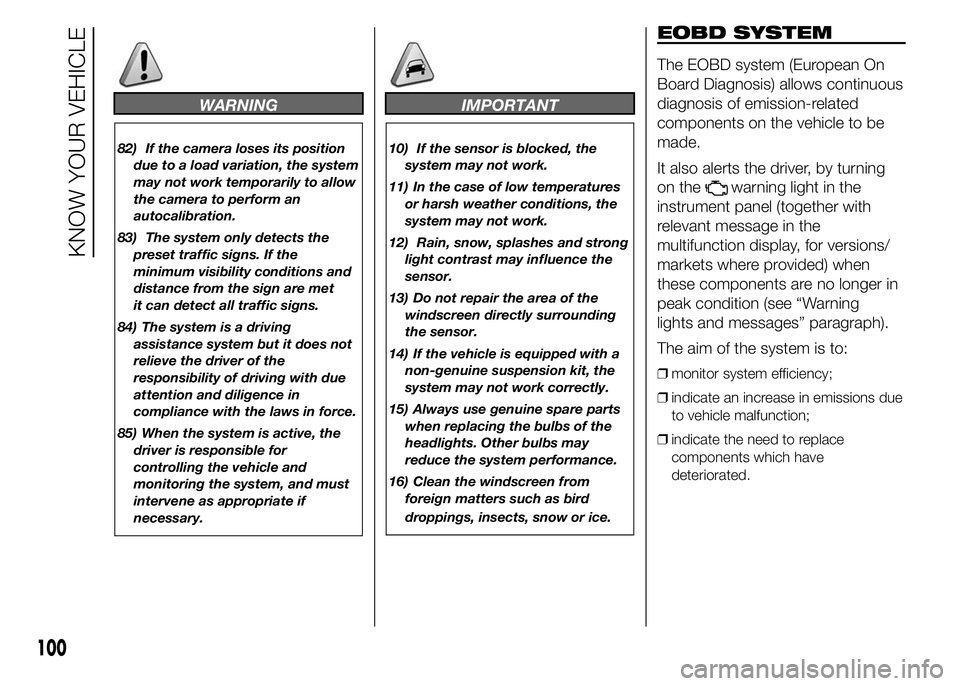
WARNING
82) If the camera loses its position
due to a load variation, the system
may not work temporarily to allow
the camera to perform an
autocalibration.
83) The system only detects the
preset traffic signs. If the
minimum visibility conditions and
distance from the sign are met
it can detect all traffic signs.
84) The system is a driving
assistance system but it does not
relieve the driver of the
responsibility of driving with due
attention and diligence in
compliance with the laws in force.
85) When the system is active, the
driver is responsible for
controlling the vehicle and
monitoring the system, and must
intervene as appropriate if
necessary.
IMPORTANT
10) If the sensor is blocked, the
system may not work.
11) In the case of low temperatures
or harsh weather conditions, the
system may not work.
12) Rain, snow, splashes and strong
light contrast may influence the
sensor.
13) Do not repair the area of the
windscreen directly surrounding
the sensor.
14) If the vehicle is equipped with a
non-genuine suspension kit, the
system may not work correctly.
15) Always use genuine spare parts
when replacing the bulbs of the
headlights. Other bulbs may
reduce the system performance.
16) Clean the windscreen from
foreign matters such as bird
droppings, insects, snow or ice.
EOBD SYSTEM
The EOBD system (European On
Board Diagnosis) allows continuous
diagnosis of emission-related
components on the vehicle to be
made.
It also alerts the driver, by turning
on the
warning light in the
instrument panel (together with
relevant message in the
multifunction display, for versions/
markets where provided) when
these components are no longer in
peak condition (see “Warning
lights and messages” paragraph).
The aim of the system is to:
❒monitor system efficiency;
❒indicate an increase in emissions due
to vehicle malfunction;
❒indicate the need to replace
components which have
deteriorated.
100
KNOW YOUR VEHICLE
Page 106 of 367
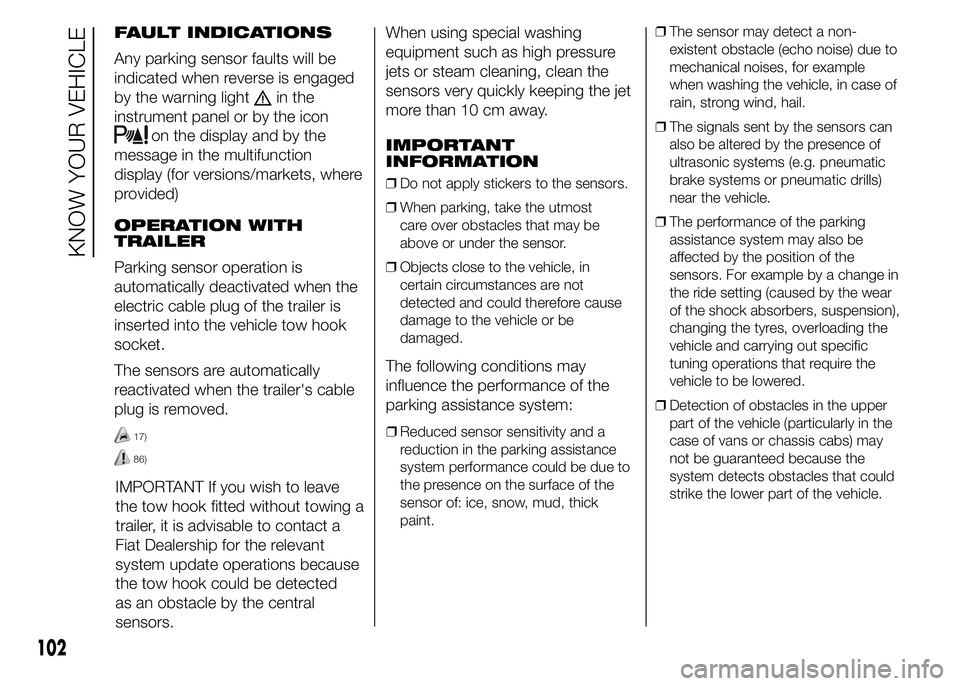
FAULT INDICATIONS
Any parking sensor faults will be
indicated when reverse is engaged
by the warning light
in the
instrument panel or by the icon
on the display and by the
message in the multifunction
display (for versions/markets, where
provided)
OPERATION WITH
TRAILER
Parking sensor operation is
automatically deactivated when the
electric cable plug of the trailer is
inserted into the vehicle tow hook
socket.
The sensors are automatically
reactivated when the trailer's cable
plug is removed.
17)
86)
IMPORTANT If you wish to leave
the tow hook fitted without towing a
trailer, it is advisable to contact a
Fiat Dealership for the relevant
system update operations because
the tow hook could be detected
as an obstacle by the central
sensors.When using special washing
equipment such as high pressure
jets or steam cleaning, clean the
sensors very quickly keeping the jet
more than 10 cm away.
IMPORTANT
INFORMATION
❒Do not apply stickers to the sensors.
❒When parking, take the utmost
care over obstacles that may be
above or under the sensor.
❒Objects close to the vehicle, in
certain circumstances are not
detected and could therefore cause
damage to the vehicle or be
damaged.
The following conditions may
influence the performance of the
parking assistance system:
❒Reduced sensor sensitivity and a
reduction in the parking assistance
system performance could be due to
the presence on the surface of the
sensor of: ice, snow, mud, thick
paint.❒The sensor may detect a non-
existent obstacle (echo noise) due to
mechanical noises, for example
when washing the vehicle, in case of
rain, strong wind, hail.
❒The signals sent by the sensors can
also be altered by the presence of
ultrasonic systems (e.g. pneumatic
brake systems or pneumatic drills)
near the vehicle.
❒The performance of the parking
assistance system may also be
affected by the position of the
sensors. For example by a change in
the ride setting (caused by the wear
of the shock absorbers, suspension),
changing the tyres, overloading the
vehicle and carrying out specific
tuning operations that require the
vehicle to be lowered.
❒Detection of obstacles in the upper
part of the vehicle (particularly in the
case of vans or chassis cabs) may
not be guaranteed because the
system detects obstacles that could
strike the lower part of the vehicle.
102
KNOW YOUR VEHICLE
Page 107 of 367
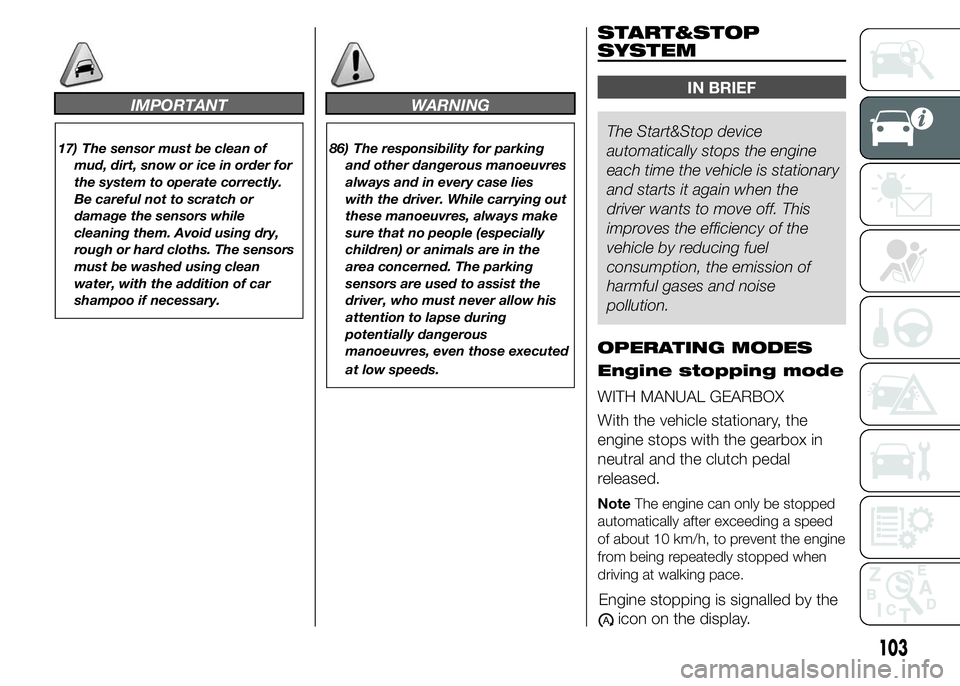
IMPORTANT
17) The sensor must be clean of
mud, dirt, snow or ice in order for
the system to operate correctly.
Be careful not to scratch or
damage the sensors while
cleaning them. Avoid using dry,
rough or hard cloths. The sensors
must be washed using clean
water, with the addition of car
shampoo if necessary.
WARNING
86) The responsibility for parking
and other dangerous manoeuvres
always and in every case lies
with the driver. While carrying out
these manoeuvres, always make
sure that no people (especially
children) or animals are in the
area concerned. The parking
sensors are used to assist the
driver, who must never allow his
attention to lapse during
potentially dangerous
manoeuvres, even those executed
at low speeds.
START&STOP
SYSTEM
IN BRIEF
The Start&Stop device
automatically stops the engine
each time the vehicle is stationary
and starts it again when the
driver wants to move off. This
improves the efficiency of the
vehicle by reducing fuel
consumption, the emission of
harmful gases and noise
pollution.
OPERATING MODES
Engine stopping mode
WITH MANUAL GEARBOX
With the vehicle stationary, the
engine stops with the gearbox in
neutral and the clutch pedal
released.
NoteThe engine can only be stopped
automatically after exceeding a speed
of about 10 km/h, to prevent the engine
from being repeatedly stopped when
driving at walking pace.
103
Engine stopping is signalled by the
icon on the display.